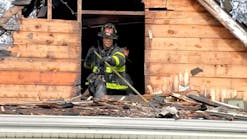The fire service is rich in history and tradition. This makes us what we are today. In fact, many argue it is what makes change in our industry so difficult. We tend to have an attitude of "we have always done it that way." Many of us remember when hazmat was new to our service or even when your fire department did not provide EMS. There will soon be a generation of fire service personnel who do not remember when terrorism was really not on the forefront of our training topics.
We have made progress as a service. We now tend to move toward customer service and firefighter safety and health initiatives are becoming more prevalent in our industry. However, we still have not embraced fire prevention as one of our critical services. These attitudes, beliefs and group norms are unfortunately the culture of many fire departments. Fire departments ranging from large suburban departments to volunteer departments tend to view fire prevention as work performed by another entity within the fire department. How can we change these beliefs and norms and is it really necessary to do so?
Prevention Increases Firefighter Safety
An effective fire prevention program does not only serve the citizens but also serves fire suppression personnel. Fire prevention and mitigation efforts equate to firefighter safety. The early efforts of fire prevention and mitigation during the construction of a building will help to "shape the battlefield" when an incident does occur.
When suppression personnel are called for a fire in commercial structure at 3:00 a.m., where is the hydrant? Is there an available water supply? Where is the fire department connection? Where is the fire alarm control panel? The answers to these questions are, it depends. In fact one could say it depends on your fire prevention bureau. Having fire protection systems in place and accessible for use to meet the operations of the fire department is crucial during a fire incident.
We believe many fire suppression personnel see the value of fire prevention efforts. However, do they see the value of fire prevention just as important as the duties they perform? Many will argue, they did not join the fire service for fire prevention and they want to fight fires or provide EMS.
As a fire service profession, we need to begin a culture shift in our service to educate the fire service on how fire prevention efforts benefit them directly and their work environment. Fire departments need to incorporate fire prevention efforts as part of the job descriptions for fire suppression personnel. We do not have to wait until the professional qualification standards force us to address this. Each fire department has the opportunity to modify their respective job descriptions to address this. These efforts need to then be linked to the performance reviews of the fire fighter. We need to foster a culture which incorporates fire prevention as our first efforts.
Starting the Culture Change
Modifying an organization's culture is not easy, let alone an entire entity such as the fire service. This is not an impossible task. The first step begins with the chief of the organization who can foster an environment that rewards fire prevention efforts. The organization can establish a culture where fire suppression personnel agree to the role of fire prevention and clearly have been taught how fire prevention benefits them and their fellow firefighters.
One of the key starting points of fire prevention education training is at the recruit level. We do not spend enough time teaching recruits the benefits and importance of fire prevention. Sure we go over fire sprinklers, fire alarms and standpipes but do we address a total fire prevention program to include fire and life safety education, fire inspections, construction document review and fire suppression system maintenance? We were excited to learn at the last International Fire Service Training Association (IFSTA) validation conference that the new edition of Essentials of Fire Fighting contains information on basic fire and life safety education techniques for firefighters. The bonus instruction CD that accompanies each manual provides a video of how to conduct a basic classroom presentation for fire safety as well conducting a station tour. Using this training material in recruit training academies will begin the culture shift.
Even if your fire department has fostered a culture of fire prevention, it still can be difficult to have individuals willing to move from fire suppression to fire prevention or to keep the culture of fire prevention. Fire chiefs and city managers can address this by having a clear and defined career path for fire prevention personnel regardless of their status as sworn or civilian. City managers can target fire prevention during budget cuts or consolidation efforts with other municipal entities. There are fire departments that no longer have fire prevention as part of their service. This role has been consolidated with either community development or public works.
We must stay the course and keep fire prevention as part of our service and move forward to making fire prevention as much of our culture as fire suppression and EMS. We would not transfer an engine or truck company to the community development department so why even consider fire prevention personnel?
We know fire prevention takes more than people. It takes the culture of an entire organization. Just as we focus our efforts to change the norms and beliefs to make it "OK to be safe", let's make it "OK for everyone in the organization to embrace fire prevention." In order to do this it will take a culture.
BRETT LACEY, a Firehouse.com Contributing Editor, is the Fire Marshal for the Colorado Springs, CO, Fire Department and a professional engineer. He has over 27 years in the fire service and has served on various technical committees including NFPA 1031, IFSTA committee for Inspection practices, and Fire Detection and Suppression Systems and the Colorado Fire Marshal's Association Code Committee. PAUL VALENTINE, a Firehouse.com Contributing Editor, is the Fire Marshal for the Mount Prospect, IL, Fire Department and formerly served as their fire protection engineer. He has a Bachelor of Science Degree in Fire Protection and Safety Engineering Technology from Oklahoma State University and a Master of Science Degree in Management and Organizational Behavior from Benedictine University and is a graduate from the National Fire Academy's Executive Fire Officer Program. Brett and Paul co-authored Fire Prevention Applications, published by Fire Protection Publications. They also presented a webcast titled Fire Prevention Applications on Firehouse TrainingLIVE. To read their complete biographies and view their archived articles, click here. You can reach Paul by e-mail at: [email protected].





